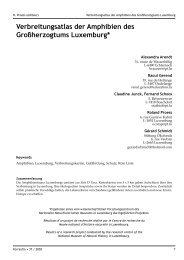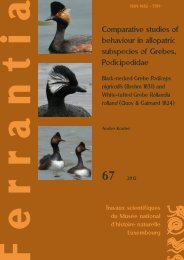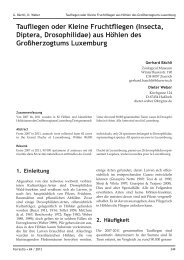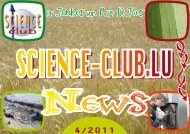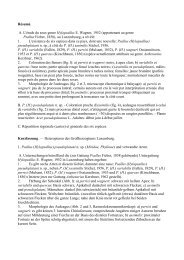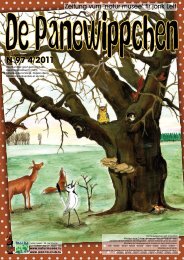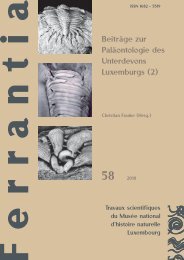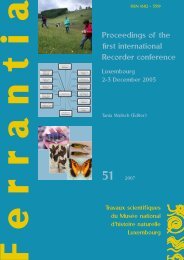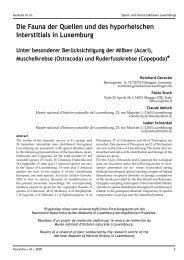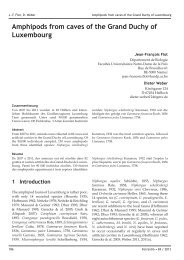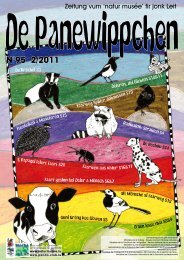Ferrantia 66 Die Graslandgesellschaften Luxemburgs
Ferrantia 66 Die Graslandgesellschaften Luxemburgs
Ferrantia 66 Die Graslandgesellschaften Luxemburgs
Erfolgreiche ePaper selbst erstellen
Machen Sie aus Ihren PDF Publikationen ein blätterbares Flipbook mit unserer einzigartigen Google optimierten e-Paper Software.
S. Schneider <strong>Die</strong> <strong>Graslandgesellschaften</strong> <strong>Luxemburgs</strong><br />
Trespen-Halbtrockenrasen, Goldhaferwiesen und<br />
artenreichen Glatthaferwiesen. Des Weiteren sind<br />
die Kleinseggenriede, Großseggenriede und artenreichen<br />
Feuchtwiesen sowie deren Brachestadien<br />
in Luxemburg gefährdet. Einzelne <strong>Graslandgesellschaften</strong><br />
sind nur noch in Naturschutzgebieten<br />
gut erhalten. <strong>Die</strong> naturschutzfachliche<br />
Bewertung umfasst allgemein gültige Nutzungsund<br />
Pflegeempfehlungen, die zum Erhalt der<br />
selten werdenden <strong>Graslandgesellschaften</strong> und<br />
ihrer Flora beitragen sollen.<br />
<strong>Die</strong> vorliegende vegetationskundliche Bearbeitung<br />
der Graslandvegetation soll als Grundlage für<br />
naturschutzfachliche Planungen dienen.<br />
7. Summary<br />
The present work gives a first overview on the<br />
plant communities of the grassland of Luxembourg<br />
by typing, classifying and describing them<br />
comprehensively.<br />
The phytosociological classification is based on 793<br />
vegetation relevés from 25 unpublished works of<br />
the last 35 years as well as on 413 relevés recorded<br />
in the years 2006 to 2009, whereby these current<br />
data mostly document nutrient-poor meadows.<br />
Degraded vegetation stands lacking characteristic<br />
species as well as transition communities were<br />
included beyond well minted ones in order to<br />
reflect the current variety of grassland.<br />
The phytosociological evaluation resulted in<br />
altogether 31 plant communities. The floristic<br />
classification of the grassland communities in<br />
units and variants follows primarily ecological<br />
gradients of nutrient, acidity and water supply as<br />
well as type and intensity of agricultural land use.<br />
The subunits are characterized on the basis of the<br />
respective group of differential species and their<br />
location requirements. In the 21 vegetation tables<br />
the diagnostic species of the grassland communities<br />
as well as their differentiating species<br />
groups are identified.<br />
The majority of the vegetation units belong<br />
syn-systematically to the class Molinio-Arrhenatheretea<br />
(cultivated meadows and related vegetation<br />
types) with plant communities from the following<br />
alliances: Calthion palustris, Molinion caeruleae,<br />
Arrhenatherion elatioris, Polygono-Trisetion and<br />
<strong>Ferrantia</strong> • <strong>66</strong> / 2011<br />
Potentillion anserinae. Furthermore plant communities<br />
of the Magnocaricion elatae, Caricion nigrae,<br />
Bromion erecti and Violion caninae are described.<br />
When describing grassland communities the<br />
focus is mainly put on the species composition<br />
regarding characteristic and diagnostic species.<br />
Besides the various and remarkable flowering<br />
aspects of grassland as well as their structural<br />
characteristics are emphasized. Furthermore<br />
the description contains information on the<br />
current distribution of these plant communities<br />
in Luxembourg. The grassland communities are<br />
characterized regarding their conservation status<br />
and protection value in Luxembourg as well as<br />
classified regarding their protection status with<br />
respect to the European Habitats Directive and<br />
the current law of nature conservation of Luxembourg.<br />
The protection value is evaluated among<br />
other things on basis of rare and endangered<br />
flowering plants as well as floristic rarities.<br />
In addition to own results and observations, the<br />
common stand of knowledge over the grassland<br />
communities regarding their ecology, land use and<br />
value for nature conservation based was collected<br />
from literature and comprehensively inserted.<br />
The syntaxonomic classification, the demarcation<br />
of the plant communities as well as their naming<br />
takes place critically, including supra-regional<br />
monographs as well as German overviews.<br />
The Calthion-alliance-community and the Arrhenatheretum<br />
elatioris, which are especially well documented<br />
by a huge number of relevés, take the emphasis<br />
within the examined syntaxa, which subdivide<br />
into a multiplicity of subunits. The False Oatgrass<br />
meadows particularly exhibit a broad amplitude<br />
regarding water, nutrient and base supply.<br />
The demarcation and allocation of some grassland<br />
communities proved to be difficult due to close<br />
spatial mixing and to transitions towards ecologically<br />
and floristically related syntaxa and were<br />
thus in each case described in detail.<br />
The geographical distribution of many grassland<br />
communities can be attributed to the natural<br />
conditions of Luxembourg, in particular regarding<br />
geology and climate. While some plant communities<br />
almost exclusively occur on the base-richer<br />
substrates in the south (Gutland), others are found<br />
only on the acidic grounds in the devonian north<br />
(Ösling), belonging to the Rhenish Uplands.<br />
213



